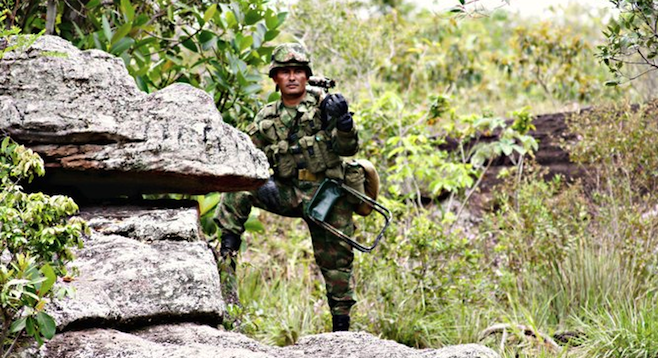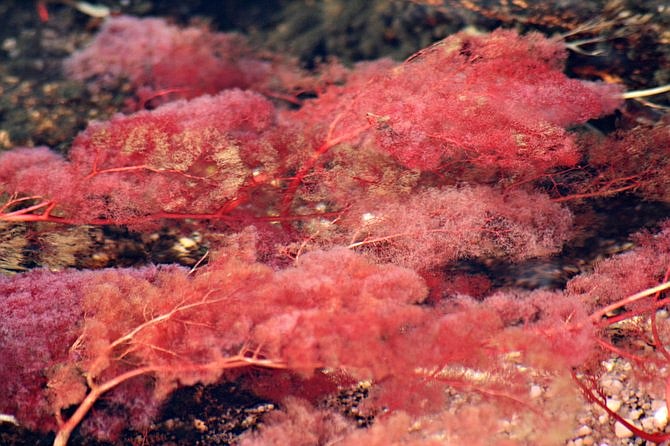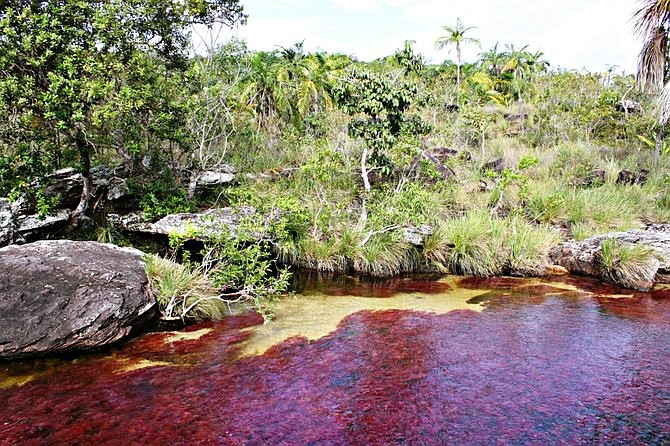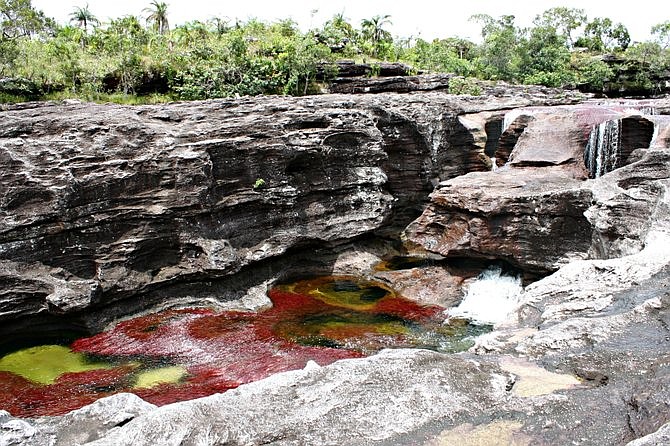 Facebook
Facebook
 X
X
 Instagram
Instagram
 TikTok
TikTok
 Youtube
Youtube

The army sharpshooter looks us up and down, his anti-guerrilla livery emblazoned on a tightly wound bandana. He establishes quickly that we represent no threat, shows us his rifle and smiles, revealing braces.

Incongruous, I think, train tracks on a sniper. But then, everything has been incongruous here, from the parallel state the leftist FARC guerrillas used to overlord in La Macarena to the brilliant colors of the water-borne Macarenia clavígera plants that make the park where Caño Cristales is located so special.
In theory, this is why I am here. To see and photograph the mythical river of burgundy that is supposedly one of a kind – unique to Colombia and conjuring up all sorts of pithy metaphors and taglines so beloved of tourist brochures and travel agencies.
Our guide is Yerlis Bustamente, a 22-year-old former raspachin. Yerlis says of his earlier profession harvesting coca plants and picking leaves for the production of cocaine, “It was hard work, but what other options were there?”
Yerlis gauges us immediately: a journalist and a couple of photographers. We want content, images and anecdotes. His blasé conversation about the FARC (Revolutionary Armed Forces of Colombia) and how life used to be in this area reaffirms that tourism in Colombia – beyond the obvious areas of the Caribbean island of San Andrés and the coastal colonial city of Cartagena – remains reserved for specialists.
To put this Colombian adventure tourism into context: after much negotiating, cruise ships returned to Cartagena in 2007, and tourists were only legally permitted to visit Caño Cristales in 2008. I hasten to add this is not paradise; it’s an adventure. For so long, a trip to this region was not even possible.
This river and national park are refreshingly bereft of legends and folklore, unlike so many other places available to visit in Colombia.
There has been no appearance of the Virgin Mary and no mention of La Llorona (Weeping Woman) nor El Hombre Caimán (Alligator Man). Perhaps this is because it was officially “discovered” as recently as 1968 by some cattle farmers and then subsequently off-limits due to an escalation in the conflict between the government and the FARC. Long had I harbored dreams of holidays in the “red zone,” but since my move to Colombia in 2007, no agency was prepared to offer the logistics.
Until recently, I would have required special permission from the military. Now, anyone can manage it independently with newly installed flights to the town of La Macarena from Bogotá.
Just one hour south of the Colombian capital by plane, La Macarena was effectively the front line between the government and the rebels. Now it’s a tourist destination. How things change, I think, as I am ushered under a corrugated iron roof to watch a performance of local traditional joropo dancing and music and feast on succulent carne a la llanera. The local efforts are a noble attempt to turn the page on the past and seduce us with the natural beauty and beguiling local customs. But there is no mistaking that the contemporary history of the region is an attraction as well.
La Macarena fell within the boundaries of a former demilitarized zone. Some things have not changed despite the turnover in authorities. Evening lights burn bright in the town’s denizen of pool halls during the 10 hours of electricity provided by a military generator, before an abrupt blackout plunges the area into a humid and inky end to the day. It’s a curious feeling, being in a Colombian town without the feedback and distortion from an over-amped speaker, raucous vallenato music or audible soap operas filling every front room.
Prices for consumer goods remain high in La Macarena, a throwback to when everything was bought and sold with coca paste, panned gold, dollars or any other available hard currency. With such inflated prices for the simplest things – a knock-off Totto backpack or some Venezuelan Converse sneakers – it is no wonder most families here had a line at some level in the illicit trade. This was survival. This was the economy.

Tourism holds great promise to the community, and certainly the 30 or so young guides who now greet tourists at the airstrip and accompany them for the duration of their stay are positive. But it cannot be everything. Caño Cristales is special and certainly merits a few days to ensure you get the favorable light to observe, photograph and enjoy the colors of the river, but bear in mind there is technically a five-month window from June to November when the plants are in flower. The rest of the year, this is just an ordinary river, albeit in a fascinating geographical formation where the savannas meet the Amazon on the back of the Guyanese Shield.
Weather and timing are everything, as we discover. Only a week previously there had been a great deal of sun, no rain, and the river levels dropped, burning the red plants and turning them a coffee brown. Fortunately, some rain had since fallen, giving rise to new growth of the red plants whose stems up close resemble the veins in a bloodshot eyeball.
I feel the back of my neck burning in the equatorial sun. Despite hiking through shaded points, everything we want and need to see is exposed, and sunblock is prohibited here due to its effect on the river’s plants. I suppose hanging off the back of the 4×4 to photograph the countryside and view the FARC-built highway is not the wisest move.
But here it is, a scarring feature made from sand and rubble in a swathe of the Colombian savannah, connecting La Macarena with the towns of Vista Hermosa to the north and San Vicente del Caguan in the west. This is an unexplored Colombia that represents not the first or second wave of tourism destinations in Colombia, but more appropriately the fourth or fifth.
I am impressed; this road is better than some I have seen elsewhere in more populous areas of Colombia. But Yerlis corrects me: I wouldn’t want to try it in the rainy season or even today, as we would likely get bogged down and stuck in the middle of nowhere with precious little shade. He further adds it was built by guerrillas and townsfolk facing punishment for crimes committed. No different from a conventional penal chain gang.
Nearby on a rise are the remnants of the FARC’s radio antenna. From here, they broadcasted their station “La Voz de la Resistencia” – and continuing in the theme of running a parallel state within a state, instead of playing the Colombian national anthem at 6 a.m. and 6 p.m. as is the norm here, they played the FARC’s ditty.
I have been drawn here by a true wonder of nature, and I am hoping to see more birdlife – apparently I am just unlucky – but I leave feeling enriched in a contemporary sense of understanding a little more about the Colombian conflict. The Macarenenses had it tough but are trying to find a way forward through tourism.

Certainly, their land plays host to something tragically fragile and at the same time extremely special and, as tourism grows, it needs to be protected. The Macarenia clavígera is unforgettable and spellbinding, but would it be so special if it were not in a destination that inspires so much mystique? After all, precious few people have been here since 1968.
Is it the contemporary culture that is spellbinding, or the curiosity of nature that provides such an anomaly as a river running blood-red through the Colombian hinterlands?


The army sharpshooter looks us up and down, his anti-guerrilla livery emblazoned on a tightly wound bandana. He establishes quickly that we represent no threat, shows us his rifle and smiles, revealing braces.

Incongruous, I think, train tracks on a sniper. But then, everything has been incongruous here, from the parallel state the leftist FARC guerrillas used to overlord in La Macarena to the brilliant colors of the water-borne Macarenia clavígera plants that make the park where Caño Cristales is located so special.
In theory, this is why I am here. To see and photograph the mythical river of burgundy that is supposedly one of a kind – unique to Colombia and conjuring up all sorts of pithy metaphors and taglines so beloved of tourist brochures and travel agencies.
Our guide is Yerlis Bustamente, a 22-year-old former raspachin. Yerlis says of his earlier profession harvesting coca plants and picking leaves for the production of cocaine, “It was hard work, but what other options were there?”
Yerlis gauges us immediately: a journalist and a couple of photographers. We want content, images and anecdotes. His blasé conversation about the FARC (Revolutionary Armed Forces of Colombia) and how life used to be in this area reaffirms that tourism in Colombia – beyond the obvious areas of the Caribbean island of San Andrés and the coastal colonial city of Cartagena – remains reserved for specialists.
To put this Colombian adventure tourism into context: after much negotiating, cruise ships returned to Cartagena in 2007, and tourists were only legally permitted to visit Caño Cristales in 2008. I hasten to add this is not paradise; it’s an adventure. For so long, a trip to this region was not even possible.
This river and national park are refreshingly bereft of legends and folklore, unlike so many other places available to visit in Colombia.
There has been no appearance of the Virgin Mary and no mention of La Llorona (Weeping Woman) nor El Hombre Caimán (Alligator Man). Perhaps this is because it was officially “discovered” as recently as 1968 by some cattle farmers and then subsequently off-limits due to an escalation in the conflict between the government and the FARC. Long had I harbored dreams of holidays in the “red zone,” but since my move to Colombia in 2007, no agency was prepared to offer the logistics.
Until recently, I would have required special permission from the military. Now, anyone can manage it independently with newly installed flights to the town of La Macarena from Bogotá.
Just one hour south of the Colombian capital by plane, La Macarena was effectively the front line between the government and the rebels. Now it’s a tourist destination. How things change, I think, as I am ushered under a corrugated iron roof to watch a performance of local traditional joropo dancing and music and feast on succulent carne a la llanera. The local efforts are a noble attempt to turn the page on the past and seduce us with the natural beauty and beguiling local customs. But there is no mistaking that the contemporary history of the region is an attraction as well.
La Macarena fell within the boundaries of a former demilitarized zone. Some things have not changed despite the turnover in authorities. Evening lights burn bright in the town’s denizen of pool halls during the 10 hours of electricity provided by a military generator, before an abrupt blackout plunges the area into a humid and inky end to the day. It’s a curious feeling, being in a Colombian town without the feedback and distortion from an over-amped speaker, raucous vallenato music or audible soap operas filling every front room.
Prices for consumer goods remain high in La Macarena, a throwback to when everything was bought and sold with coca paste, panned gold, dollars or any other available hard currency. With such inflated prices for the simplest things – a knock-off Totto backpack or some Venezuelan Converse sneakers – it is no wonder most families here had a line at some level in the illicit trade. This was survival. This was the economy.

Tourism holds great promise to the community, and certainly the 30 or so young guides who now greet tourists at the airstrip and accompany them for the duration of their stay are positive. But it cannot be everything. Caño Cristales is special and certainly merits a few days to ensure you get the favorable light to observe, photograph and enjoy the colors of the river, but bear in mind there is technically a five-month window from June to November when the plants are in flower. The rest of the year, this is just an ordinary river, albeit in a fascinating geographical formation where the savannas meet the Amazon on the back of the Guyanese Shield.
Weather and timing are everything, as we discover. Only a week previously there had been a great deal of sun, no rain, and the river levels dropped, burning the red plants and turning them a coffee brown. Fortunately, some rain had since fallen, giving rise to new growth of the red plants whose stems up close resemble the veins in a bloodshot eyeball.
I feel the back of my neck burning in the equatorial sun. Despite hiking through shaded points, everything we want and need to see is exposed, and sunblock is prohibited here due to its effect on the river’s plants. I suppose hanging off the back of the 4×4 to photograph the countryside and view the FARC-built highway is not the wisest move.
But here it is, a scarring feature made from sand and rubble in a swathe of the Colombian savannah, connecting La Macarena with the towns of Vista Hermosa to the north and San Vicente del Caguan in the west. This is an unexplored Colombia that represents not the first or second wave of tourism destinations in Colombia, but more appropriately the fourth or fifth.
I am impressed; this road is better than some I have seen elsewhere in more populous areas of Colombia. But Yerlis corrects me: I wouldn’t want to try it in the rainy season or even today, as we would likely get bogged down and stuck in the middle of nowhere with precious little shade. He further adds it was built by guerrillas and townsfolk facing punishment for crimes committed. No different from a conventional penal chain gang.
Nearby on a rise are the remnants of the FARC’s radio antenna. From here, they broadcasted their station “La Voz de la Resistencia” – and continuing in the theme of running a parallel state within a state, instead of playing the Colombian national anthem at 6 a.m. and 6 p.m. as is the norm here, they played the FARC’s ditty.
I have been drawn here by a true wonder of nature, and I am hoping to see more birdlife – apparently I am just unlucky – but I leave feeling enriched in a contemporary sense of understanding a little more about the Colombian conflict. The Macarenenses had it tough but are trying to find a way forward through tourism.

Certainly, their land plays host to something tragically fragile and at the same time extremely special and, as tourism grows, it needs to be protected. The Macarenia clavígera is unforgettable and spellbinding, but would it be so special if it were not in a destination that inspires so much mystique? After all, precious few people have been here since 1968.
Is it the contemporary culture that is spellbinding, or the curiosity of nature that provides such an anomaly as a river running blood-red through the Colombian hinterlands?
Comments